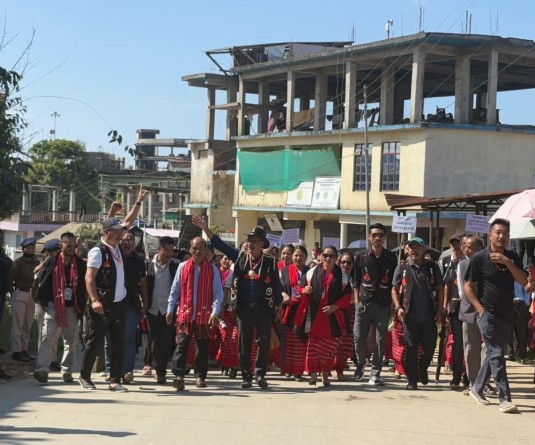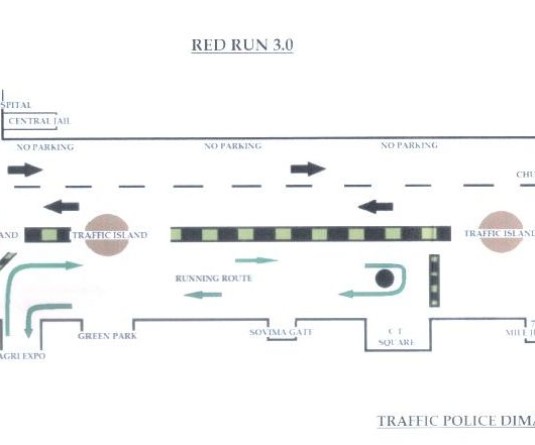
Aheli Moitra
Kohima | December 2
As Indian Express journalist Samudra Gupta Kashyap rattled off figures on migration into the states of the North East, its predominantly illegal nature and the shadow it cast on governance was beyond debate. Kashyap, on November 28, was moderating a panel discussion here on the ‘Impact of illegal migration of foreigners to the North East’ at the 5th General Conference of the North East Students’ Organisation (NESO). He addressed a Capital Convention Centre packed with student activists from all states of the North East who had worked and deliberated, over years, on the stated issue.
Almost all delegates believed that the Centre had turned a blind eye to the issue that had resulted in its proliferation. The regional outlook on the issue remains more skewed. In October, Tarun Gogoi stated that infiltration is not the biggest problem in Assam, but Kashyap believes the contrary is true, and not just in Assam.
“In October this year, the Border Security Force (BSF) in Meghalaya apprehended 72 illegal immigrants. Over the year, there were 199 such cases which are said to have been handed over to the police. It is unclear what the police did with them,” stated Kashyap in a long list of statistics that tell similar stories across states of the region.
Data suggests that from 1960-1971, 2,40,880 people came into India from East Pakistan (at the time), of which 1,92,000 were sent back but 45,000 stayed back. More recent figures from the Government of India records suggest that there are 82,000 people currently in the country who came to India on valid papers but have “disappeared”.
Correlate this to the 1,50,000 voters in Assam who fall under the ‘Doubtful’ (D) status on the voters’ list, and the other figure of 2.67 Lakh cases pending before the 36 tribunals in Assam dealing with cases of suspected illegal migrants. The actual numbers could easily be more.
Explaining the issue was President of Khasi Students’ Union (KSU), Daniel Khyriem. “Meghalaya is rich in natural resources, and one of the most peaceful states in the North East. It is a haven for international and national migrants.” According to the Meghalaya state government’s report, it detected 4,198 foreign nationals from January-September 2012, while the BSF confirmed 159 “Bangladeshi infiltrators”.
The Meghalaya-Bangladesh border remains porous to date, and infiltration is swift. Internal politics of the state enables the migrants to settle.
“There are lapses in the electoral roll. A person is allowed to enroll with documents produced from panchayats/village authority even without a citizenship document. Most of these come from Karimganj. Why are they enrolling in Meghalaya when their documents are from Assam?” questioned Khyriem whose student body (KSU) launched an agitation in July this year to stop this form of electoral roll enrollment and asked political parties not to encourage illegal immigration to protect vote banks.
Tengsak G Momin, President of the Garo Students’ Union (GSU) gave a fairly detailed paper on how illegal migrants are allowed to become valid citizens. A growing Bangladeshi population, according to him, could demand regional integration into Bangladesh in the future.
“Since the Bangladeshi migrant is poor and come here to settle, they compete with indigenous people for land, resources, services and jobs. There is evidence to suggest that in Meghalaya, these migrants are given domicile certificates by local authority and corrupt officials in exchange for small work. This gives them an entry into the electoral roll,” said Momin, resounding concerns raised by Khyriem. For both the KSU and GSU, the Indian government has not done enough to address the security lapse this causes.
“Smuggling of alcohol and drugs, and trafficking of women from Bangladesh to the Middle East through the North East is common. Almost nine terror groups have taken shelter in the North East since the 1990s,” explained Momin. Apart from the porous border, contractors are also to blame. Bangladeshi labour is unskilled and desperate, their cheaper labour then is more attractive to hire. The practice proliferates.
Through the GSU’s efforts, in 2008, 7826 suspicious names were deleted from the voters’ list in Meghalaya but much remains to be done.
According to a senior NSF leader, Ketsodi, the foothills of Nagaland and the Assam-Nagaland border are flooded with migrants involved in kidnap, murder and rape inside Nagaland. “Outsiders from UP, Bihar also come to earn their bread here, but Bangladeshis come here to settle down. Ethnic people should not become slaves in their own land,” was Ketsodi’s message, who encouraged the NESO participants to bury differences and join hands to do away with this “unwanted element”.
Arunachal Pradesh delegates agreed. For this state, the crux of the issue lay with the Nepali, Tibetan, Muslim, Chakma and Hajong people, who were “dumped into our state by the Government of India while we were still nomads in jungles,” said Tujum Poyom, General Secretary of the powerful All Arunachal Pradesh Students’ Union (AAPSU). After the state government, the AAPSU is said to be one of the strongest political forces in the state.
“Only those brought here in 1964 and 1969 should be allowed to stay on in designated areas, without citizenship or voting rights, but the rest have to go back to Bangladesh,” stressed Poyom. He also appealed to the NESO to put together a ‘pressure group’ that can act as a platform for strategizing and working together on this issue.
How this could be made possible, according to Assistant Professor of Mizoram University, Lallianchhunga, representing Mizo Zirlai Pawl (Mizo Students’ Association/MZP), is for NESO to recognize that apart from human and natural resources, the region is rich due to its social capital. This is what makes cooperative action possible in the North East.
The panelists presented more statistics to explain why this would be necessary. Representing the All Manipur Students’ Union (AMSU), Dr. M Manimohom remained concerned on the rise in Meitei Pangal (Muslim) population from 2% of the whole in 1881 to 8% in 2001. The problem, for him, began when prisoners brought to Manipur by a Meitei king in 1606 were later integrated into the Meitei society, and inter marriage resulted in a population hike. The other migrants who seem to be a problem, according to Manimohon, are the Nepali (who were brought in by the British since 1885) consisting of 2% of the current population of Manipur. The third in Manimohon’s problem list are the Chin Kukis, allowed to settle in Manipur since the 15th century by Meitei kings, who have now replaced the Tangkhul Nagas as the most populated tribe in Manipur, giving rise to communal clashes.
The AMSU has demanded for the Inner Line Permit (ILP) regime to be implemented to the entire North East.
On the role of governance, it was General Secretary of All Assam Students’ Union (AASU), Topon Kumar Gogoi, who in a concise presentation said that the non-implementation of the Assam Accord till date showed disrespect to the non violent movement against illegal migration. “The Assam border continues to remain porous; illegal migrants have still not been detected and deported,” pointed Gogoi out, punching holes in the Government of India’s said commitment towards the people of this region.
If some of the fears expressed above left little space to deliberate on minority rights, and the idea of a pluralist society, Assistant General Secretary of Tripura Students’ Forum (TSF), Sunil Debbarma, explained why. Since the merger of Tripura into the Indian Union in 1949, the influx from Bangladesh never stopped. The indigenous people who constituted 91% of the population in 1931 have been reduced to a mere 31% in 2001. This dramatic change in demography, according to Debbarma, had wide political, social and economic impact on the indigenous population that lost out on all three counts.
Through the discussion, though there seemed to be over dependence on the ‘centre’ to resolve the issue of illegal migration, which has since the time of Nehru looked at ‘foreigner phobia’ here as narrow-mindedness, it is clear that two things will need to change if the problems on NESO’s mind are to be addressed: the way India formulates policies to protect its North Eastern neighbours, and the solidarity the region shows towards its sister states.





